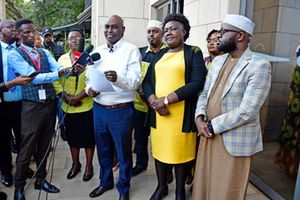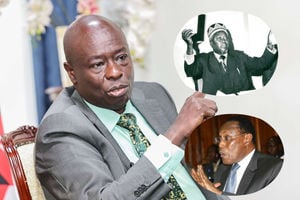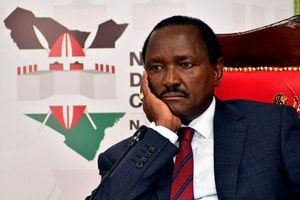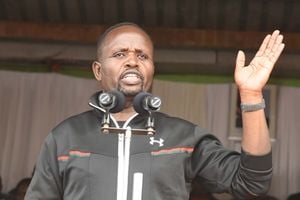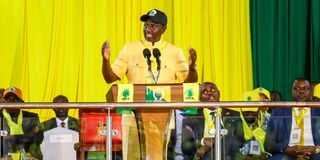
President William Ruto addressing delegates during the UDA National Governing Council meeting at the Bomas of Kenya in Nairobi on September 29, 2023.
The dalliance between the various makeshift parties that lurch for survival on the coattails of William Ruto’s United Democratic Alliance (UDA) will be tested when he demands that all these weaklings fold and join his war machine.
History has shown that failure to do that can lead to havoc, and Ruto must create his ethnoregional patrons to survive.
We all remember President Mwai Kibaki going for his second term in 2007 without an adequately configured political party and how a party known as the Party of National Unity was cobbled together at the last moment. It was disastrous.
Today, the jury is still out on whether the late president won that race against Orange Democratic Party’s Raila Odinga - whose “pentagon” symbolised chieftain politics. Mergers have become the survival kit of presidential aspirants – and for political brokers.
They have been with us since Kanu and Kadu days. For instance, Kadu was a merger of Taita Towett’s Kalenjin Political Alliance, Ronald Ngala’s Coast African Political Union, Masinde Muliro’s Kenya African Peoples Party, and Maasai United Front of John Keen.
Kanu was a merger of Oginga Odinga’s African Elected Members Organisation (AEMO), Tom Mboya’s Peoples Convention Party (PCP), remnants of James Gichuru’s banned Kenya African Union, and Argwing Kodhek’s Nairobi Convention, among others.
Later, after independence, Kenyatta had to force KADU to close shop and join his party in one of the classic mergers in Kenya that saw the birth of a de facto one-party state.
The winner in that merger was Daniel arap Moi – more than Ronald Ngala, the party leader. And that means that during such mergers, one must negotiate to survive the stampede.
One can hope those in UDA read this script correctly, for party polls can mark the onset of premium tears. The reason there is some resistance – especially from Moses Wetang’ula’s Ford Kenya – is because the party is his bargaining tool.
We all remember the story of Taita Towett when he was asked to fold his Kalenjin Political Alliance. Towett feared that he had no place within Kanu and decided to wait until a political formation with roots in the Rift Valley was founded.
On the same day, some 200 Maasai leaders including paramount chiefs, were meeting in Ngong to declare support for John Keen’s Maasai United Front as the only party representing their interests.
My advice to Wetang’ula is that there is no light at the end of the tunnel. As Kenya Kwanza politicians will soon learn, mergers come with interests and fears – both social, personal, and political.
In the 1960s, there was the fear of domination since Kanu was seen as preserving the interests of Luo and Kikuyu, the two most prominent tribes that had populated the party. More so, it stood for a centralised state while Kadu was for regionalism.
The Kenya Kwanza parties – apart from UDA – can only be distinguished by their dental formulas; nothing else separates them other than ego, hubris and their briefcase nature.

Deputy President Rigathi Gachagua arrives and is received by United Democratic Alliance leaders at Bomas of Kenya on October 13, 2023, during the United Democratic Party(UDA) National Women's Congress.
There is a lesson that Kenya Kwanza politicians digging for a fight can learn from Ronald Ngala. Let me tell you a story, Dear Moses Kuria and the company you keep of small parties: Ronald Ngala was in the US when the Kanu line-up was presented. Upon his return, he was asked before he was driven from the airport whether he would take his position as Kanu’s treasurer.
He retorted that the treasurer position was for somebody who could keep proper accounts. When asked if he would join as a member, he retorted: “I’ll think it over.” Although Ngala’s leadership acumen was well-known, he made up his mind by joining the newly formed settler-leaning Kadu.
He said: “I studied Kanu and decided it was not the party for me. It had too many leaders and there were signs that they could be pulled one against the other.” Ngala wanted to shine and sought other smaller parties as he formed the Coast African Political Union.
Ngala’s refusal to join Kanu irritated Gichuru: “We are not forcing anyone to join us. But those Africans who are not with us will in a few days regret their decisions.” Ngala later regretted that move and never rose to become a powerful politician in Kenyatta’s government. By calling for party elections, President Ruto must be having his line-up.
History, again, has shown that party polls, in most cases, rubber stamp choices made elsewhere. It is a bold move. Kanu of Jomo Kenyatta struggled to hold party elections – apart from the 1966 Limuru Conference, which was called to tame Odinga and his followers, the party did not hold elections until Kenyatta died.
There was a determined attempt to have the elections in 1977 – seen by many as effort to organise the Kenyatta succession – but this was called off at the last minute. This was because party polls tend to be divisive. In the 1977 case, which will be repeated in the UDA elections, two camps emerged.
One was led by Gikuyu Embu and Meru stalwarts who wanted to retain the status quo, and the other backed Daniel arap Moi. One should not be surprised that the UDA elections will also be testing grounds for the Ruto succession.
Unlike Uhuru Kenyatta’s “yangu kumi, ya Ruto kumi” promise, Rigathi Gachagua has no such promise. That means that there will be no hard feelings if, let’s say, Musalia Mudavadi gets an upper hand. But politics is a game of numbers, and Gachagua can marshal more delegates than Musalia. The other point to note is that not all mergers end well. Again, it is challenging to run a political party if the followers are fluid.
Look at Kanini Kega and his wing of Jubilee party and it is hard to tell where his followers reside. The only other political party that has built a grassroots base is Odinga’s ODM, whose followers are religious, committed and ready to fight for their place.
Whether Odinga gets the African Union position or not, ODM will be a party to watch since it has a stable thread in its politics, and ‘politricks’. It will be interesting to see which political parties will be willing to lose their identity to form a new party – rather than a coalition. Since the resumption of multi-party politics in 1992, tribal and regional political parties emerged, coalescing around their titular tribal leaders.
Others, like Ford Kenya, have degenerated from a national political party to a Bungoma-based outfit. And even in that space, it is now being challenged by George Natembeya’s Tawe Movement. Given the mischief of political mergers, the skulduggery nature of our politics, and the long history of backstabbing, we are all looking forward to the UDA polls to see how the party will organise its eating table.
We should all remember the words of Senator Elizabeth Warren: “If you don’t have a seat at the table, you’re probably on the menu.”
But things happen: In the 1990s, Kanu swallowed Raila’s party, he got the Secretary-General position and was eyeing the presidency on a Kanu ticket. Then Moi gave the ticket to Uhuru. George Saitoti was sidelined. It is all part of our politics. The mighty can fall. The weak can rise. But politicians never learn.

